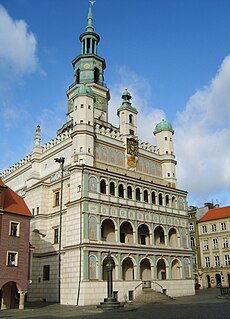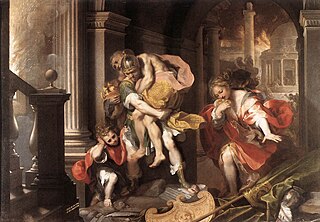
Palazzo Besta is a Renaissance building in Teglio, in the province of Sondrio, Lombardy, northern Italy.

The Renaissance is a period in European history, covering the span between the 14th and 17th centuries and marking the transition from the Middle Ages to modernity. The traditional view focuses more on the early modern aspects of the Renaissance and argues that it was a break from the past, but many historians today focus more on its medieval aspects and argue that it was an extension of the middle ages.

Teglio is a comune (municipality) in the Province of Sondrio in the Italian region Lombardy, located about 130 kilometres (81 mi) northeast of Milan and about 20 kilometres (12 mi) east of Sondrio, on the border with Switzerland.

The Province of Sondrio is in the Lombardy region of northern Italy. Its provincial capital is the town Sondrio. As of 2017, it has a population of 181,403.
It was built by the Besta family around 1433, commissioned by Azzo I and Azzo II Besta, perhaps over a pre-existing medieval edifice. Later it was owned by the Guicciardi, Quadrio and Parravicini families. It is now owned by Lombardy.
The interior has a rectangular court with a double loggia, frescoed walls (c. 1540-1630) and an octagonal well. In the first floor, all the rooms are frescoed with mythological themes, most of them from the Aeneid , the Orlando Furioso and the Bible. One, by Giuseppe Prina, portrays the Queen of Sheba received by King Solomon.

A loggia is an architectural feature which is a covered exterior gallery or corridor usually on an upper level, or sometimes ground level. The outer wall is open to the elements, usually supported by a series of columns or arches. Loggias can be located either on the front or side of a building and are not meant for entrance but as an out-of-door sitting room.

The Aeneid is a Latin epic poem, written by Virgil between 29 and 19 BC, that tells the legendary story of Aeneas, a Trojan who travelled to Italy, where he became the ancestor of the Romans. It comprises 9,896 lines in dactylic hexameter. The first six of the poem's twelve books tell the story of Aeneas's wanderings from Troy to Italy, and the poem's second half tells of the Trojans' ultimately victorious war upon the Latins, under whose name Aeneas and his Trojan followers are destined to be subsumed.

Orlando Furioso is an Italian epic poem by Ludovico Ariosto which has exerted a wide influence on later culture. The earliest version appeared in 1516, although the poem was not published in its complete form until 1532. Orlando Furioso is a continuation of Matteo Maria Boiardo's unfinished romance Orlando Innamorato. In its historical setting and characters, it shares some features with the Old French Chanson de Roland of the eleventh century, which tells of the death of Roland. The story is also a chivalric romance which stemmed from a tradition beginning in the late Middle Ages and continuing in popularity in the 16th century and well into the 17th.
In the lower ground is housed the "Antiquarium Tellinum" Museum, housing prehistorical slabs.








